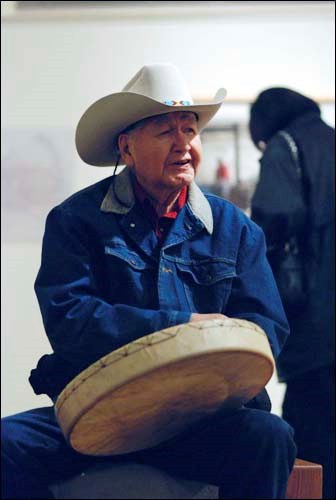The newest exhibit at the Allen Sapp Gallery compares and contrasts the personal approach in Sapp's portraits with the more detached view offered by early photographs of aboriginals, but it also introduced a new face to the gallery, that of Marcus Miller.
Miller's first exhibit as the City of North Battleford's director of galleries and curator of the Allen Sapp Gallery was unveiled Dec. 3.
The wine and cheese reception was accompanied by the hauntingly beautiful flute music of Jason Chamakese of Pelican Lake First Nation and guests were also treated to the drumming of the legendary Allen Sapp himself.
The paintings on the wall weren't all that was changed for the exhibit; the gallery is also sporting new floors and freshly painted walls.
"There were endless details to look after," said Miller. "This place was a mess for three weeks, four weeks - it was awful."
When asked how he felt to finally have the doors open on the exhibit, Miller replied in jest, "Maybe you have to ask me tomorrow."
The exhibit, Portraits: Painting, Face-Pulling and Storytelling, features paintings by Allen Sapp and photographs from the Drumming Hill Collection, which Wes Fineday, local artist and historian, loaned the gallery for the exhibit.
"Wes was interested in the idea right from the start," said Miller. "He started coming in with suitcases full of photos and he had story after story to tell."
The camera was dubbed "the face-puller" by aboriginals for its ability to capture in exactitude the likeness of a person.
Fineday explained photographers were often mistrusted by First Nations people not only because of the technology, but because they had little control over what the images would portray or how they would be used.
"But the photographs are also portraits," Fineday said, adding that although there is the added layer of technology between the artist and subject, some of the relationship between the two is still discernableby the viewer.
"In some cases, you can see there is a personal connection," said Fineday. "It's someone they knew and cared about and loved."
Fineday also said that while photographs typically represent one specific moment in time, Sapp's portraits and paintings depict scenes that are familiar for many First Nations.
"There are stories, layers and layers of stories in that one piece of artwork," said Fineday, pointing to the Sapp painting, Picking Roots.
He said although there is a general feeling conveyed by such paintings, people will depend on their own experience to make sense of the work.
"It's like when you read a book, the only way that book is going to make sense to you is to view it with your own cultural context," adding Sapp's work, accompanied by stories, offers a window into First Nations culture.
"The paintings are a reflection of a lifestyle that has changed dramatically since we were young," said Fineday.
Portraits: Painting, Face-Pulling and Storytelling will be on display in the Allen Sapp Gallery until June 2011.

.png;w=120;h=80;mode=crop)


